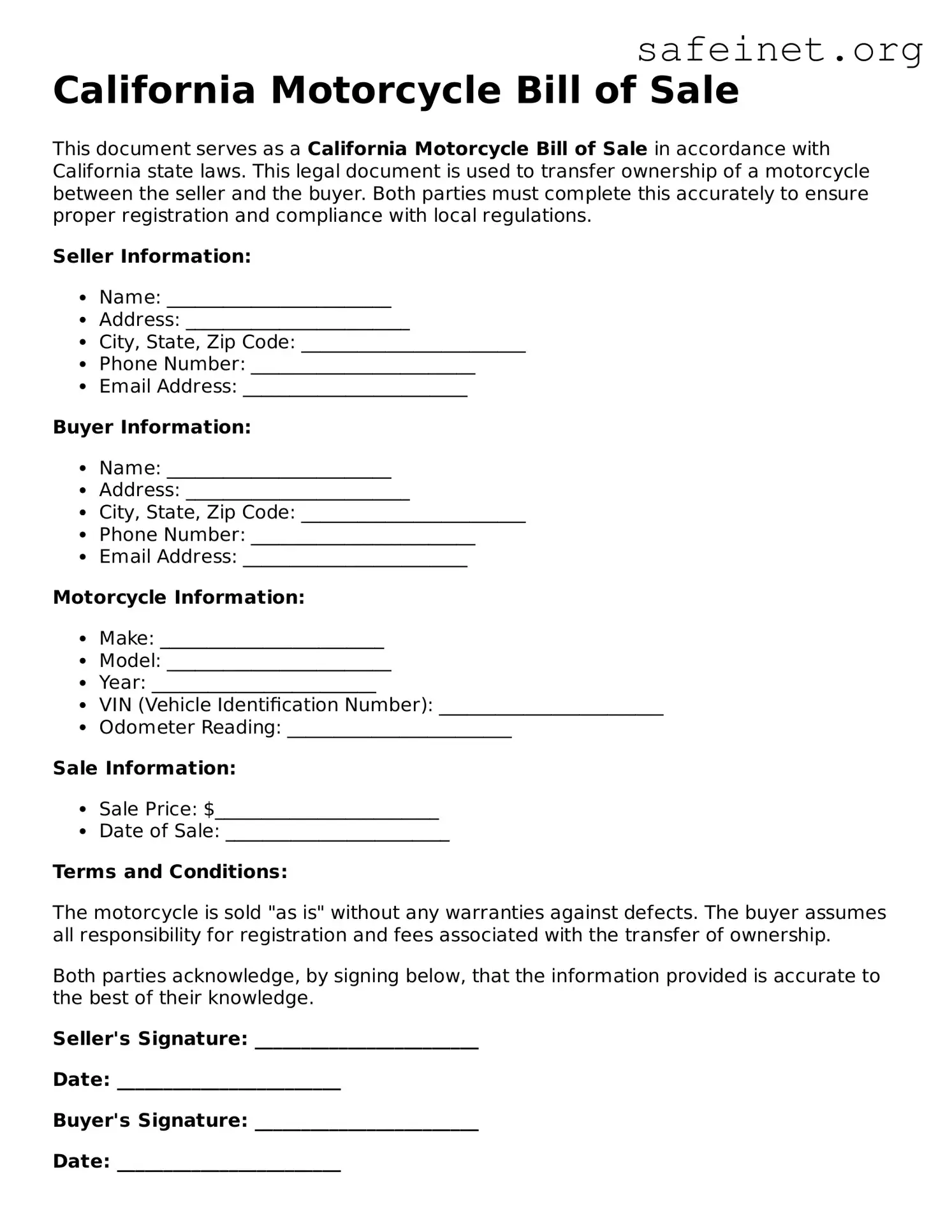The California Vehicle Bill of Sale is a document that serves a similar purpose, as it records the sale of a vehicle, including cars and trucks. This form contains information about the seller, buyer, vehicle details, and the sale price. Like the Motorcycle Bill of Sale, it provides legal proof of ownership transfer, ensuring both parties can reference the terms of the transaction. This document is particularly important when registering the vehicle with the state or obtaining a title.
The California Boat Bill of Sale also parallels the Motorcycle Bill of Sale in that it documents the sale of a watercraft. This form includes details such as the boat's identification number, seller and buyer information, as well as the sale price. Both documents serve to protect the interests of both buyer and seller, making it clear who owns the asset and establishing a record of the transaction for future reference.
The California Trailer Bill of Sale functions in a similar manner, as it pertains to the sale of trailers. It captures essential information like the trailer's make, model, and identification number, along with details about the seller and buyer. Similar to the Motorcycle Bill of Sale, it acts as proof of ownership transfer and can be important in the registration process.
The Personal Watercraft Bill of Sale is another related document. This form is used specifically for the sale of personal watercraft, such as jet skis. It includes the seller's and buyer's information, as well as details on the watercraft itself. Just like the Motorcycle Bill of Sale, it provides legal protection and clarity regarding ownership, which is vital in many states for registration purposes.
The California RV Bill of Sale serves a similar function for recreational vehicles. It provides documentation of the sale, including information about the RV’s make, model, and identification number, along with the seller’s and buyer’s information. This form, like the Motorcycle Bill of Sale, helps to establish ownership transfer and is necessary for state registration.
The California Aircraft Bill of Sale is another document with similar characteristics. This form is used to document the sale of an aircraft and contains specific details regarding the airplane, such as its make, model, and registration number. It helps document ownership transfer and ensures compliance with Federal Aviation Administration requirements, much like how the Motorcycle Bill of Sale operates within state regulations.
The Boat Transfer of Ownership form is akin to the Motorcycle Bill of Sale in that it facilitates the transfer of ownership of a boat, specifically when it involves a change of title. This document captures vital information similar to the Motorcycle Bill of Sale, including both parties’ details and the purchase price. It serves as a record that can be referred to in case of disputes or future inquiries regarding ownership.
The California Lease Agreement provides a different type of ownership transfer documentation, focused instead on leasing rather than buying. While not a direct sale document, it outlines the terms of renting property or vehicles, including information about both parties. This agreement is crucial in establishing the rights and obligations of the lessee and lessor, akin to how a Motorcycle Bill of Sale outlines the responsibilities of the buyer and seller.
The Gift Letter is another alternative that documents the transfer of an asset without a sale. Although it does not involve financial exchange, it serves to officially declare that ownership of a property, including a motorcycle, has been transferred from one person to another. Similar to the Motorcycle Bill of Sale, this letter can help prevent disputes over ownership in the future.
Lastly, the Power of Attorney is a legal document that allows one person to act on behalf of another in legal affairs. While this document does not directly pertain to the sale of a motorcycle, it can be utilized to facilitate transactions in certain circumstances, such as when the seller cannot be present. This differs slightly from the Motorcycle Bill of Sale but serves to ease the process of ownership transfers in specific situations.
